Intel Core i7 4960X (Ivy Bridge E) Review
by Anand Lal Shimpi on September 3, 2013 4:10 AM EST- Posted in
- CPUs
- Intel
- Ivy Bridge
- Ivy Bridge-E
Memory Performance
Seeing as how the huge L3 cache and quad-channel memory interface are big parts of what makes Ivy Bridge E unique, I thought it might make sense to look at memory latency and bandwidth. We'll start with memory latency, compared to Ivy Bridge, Haswell and Haswell + Crystalwell.
The larger L3 cache buys IVB-E lower latency accesses for a wider range of addresses, but once you exceed the 15MB L3 cache space we see latency about on par with everything else. Only Haswell + Crystalwell manages to hold out for longer. Unfortunately that's not really a part desktop enthusiasts can buy so it's mostly an academic comparison.
The bandwidth story is an interesting one. Sandra maxes out bandwidth by driving all cores at the same time, so you get some uplift here by there simply being more cores under IVB-E's hood. But even if you divide out the number of cores, you get per core cache bandwidth figures that are extremely high (at least outside of L1). The L3 cache in particular is quite bandwidth happy.
Going outside of the L3 cache, we also see a doubling of memory bandwidth - which is expected given the doubling of memory interface width. In reality the peak memory bandwidth advantage would be even larger as IVB-E officially supports DDR3-1866 (if you only populate 1 DIMM per channel, otherwise either 1333 or 1600 is officially supported).
General Performance
I don't know that I've ever seen an Intel slide before that called out a performance degradation, but there's a first time for everything:
The problem with IVB-E vs. Haswell is that the extra large L3 cache and quad-channel memory interface are generally only useful in heavily threaded applications, which of course benefit from its 6-core configuration. In those tests that aren't heavily threaded however, IVB-E typically sees a single threaded performance deficit compared to Haswell. Given that the 4960X and Haswell based Core i7-4770K run at very similar frequencies, it's not surprising to see IVB-E take a backseat to Haswell in in "everyday computing" tasks. Intel's slide above claims about a 18% reduction in "everyday computing" performance compared to the 4770K, but in practice I found the gap to be much narrower.
Although not the best indication of overall system performance, the SYSMark 2012 suite does give us a good idea of lighter workloads than we're used to testing.
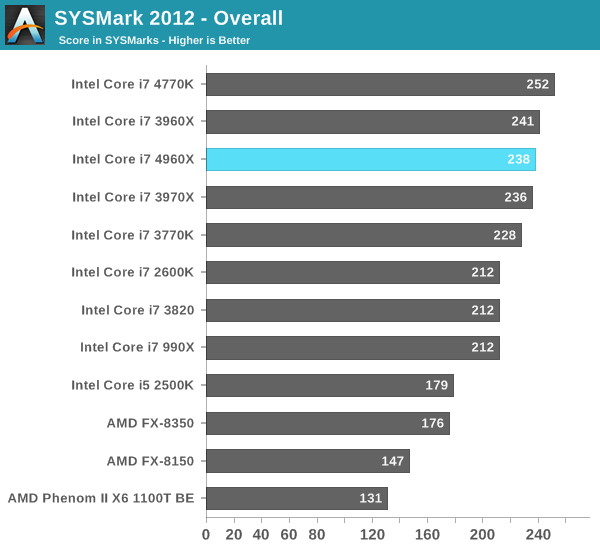
There's pretty much no advantage to the 4960X over the 3970X here. Remember Ivy Bridge's architectural improvements were very limited on the CPU side. As clock speeds didn't really go up between the 3970X and 4960X, the performance parity here isn't surprising. Haswell manages a ~6% performance advantage over the 4960X at an obviously lower power and price point.
Although I retired SYSMark 2007 a while ago, I do have much older performance data here which lets us compare the 4960X back as far as the early Pentium 4 based Extreme Edition parts:
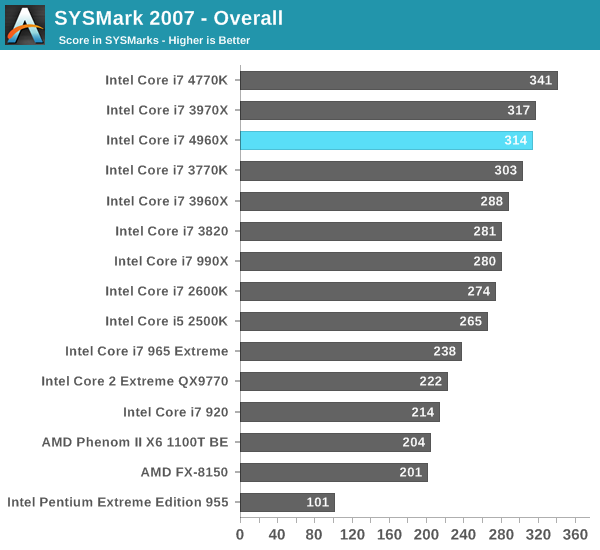
The Haswell advantage grows a bit here to around 8%, but the 4960X remains in the top three performers here. It's very clear that for most users, there are far more cost effective ways of getting great performance than IVB-E.
Our final lightly threaded test is Mozilla's Kraken JavaScript benchmark. This test includes some forward looking js code designed to showcase performance of future rich web applications on today's software and hardware. We run the test under IE10:
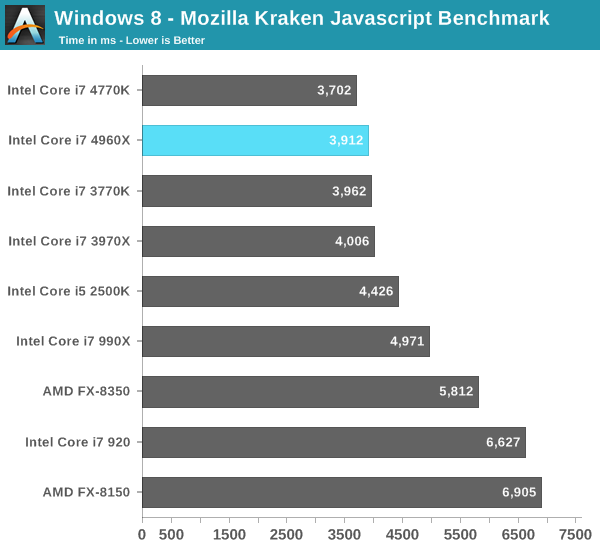
Ivy Bridge always had good single threaded performance, but once again these lightly threaded use cases are better served by an architecture with higher IPC. The Haswell advantage isn't huge, but it's a lower power/more cost effective way to get the best performance here.
If you are still on LGA-1366, you'll note that the performance gains here are good, but not earth shattering. Comparing to Intel's first 6-core platform, the 4960X manages a 27% increase in performance over the Core i7-990X. That's a healthy gain, but it's still small enough where there's no immediate need to upgrade.


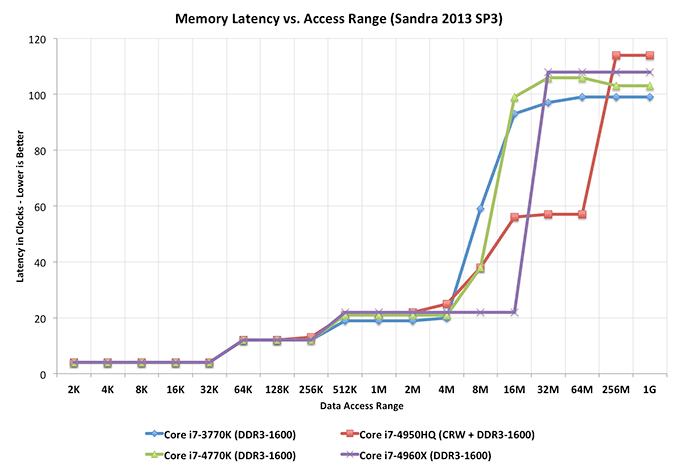
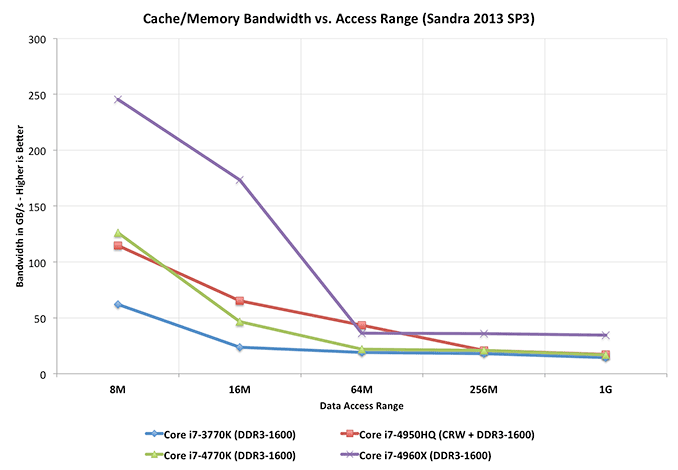
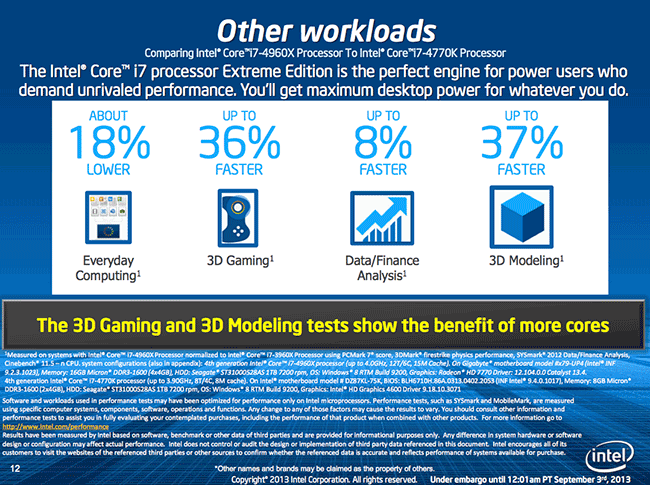








120 Comments
View All Comments
knirfie - Tuesday, September 3, 2013 - link
Why not use a gaming benchmark that does benefit from the extra cores, such as Civ5?ShieTar - Tuesday, September 3, 2013 - link
Or Starcraft 2?JarredWalton - Tuesday, September 3, 2013 - link
Hahahaha.... best 1.5 core benchmark around!althaz - Tuesday, September 3, 2013 - link
It sure does murder one core though.BrightCandle - Tuesday, September 3, 2013 - link
or Arma 3.There are games out there that can utilise more cores and yet you didn't test with any of them.
bds71 - Tuesday, September 3, 2013 - link
as someone who regularly does encoding, 4k gaming, and (when not in use otherwise) folding@home - all things which can fully leverage mult-core processors and powerfull GPUs - i look forward to these reviews of new enthusiast class processors. and, it saddens me that since SB-E there have been only marginal improvements in this sector. i never thought we (as a technology power-house, and as a society) would settle for this. for me, it all began when they started putting GPUs on-die with CPUs for desktop PCs (sure, for laptops i can certainly understand) - i mean who DOESN'T use a discreet GPU in a desktop system???? and for those who do, why don't you just get a laptop???GPUs on-die took the focus away from the CPU. and, while there are minimal gains to be had, the showing here today is abysmal. 2 yrs of waiting and we get a 5% increase (for what i do, i want power and could really care less about power draw - as i would say most enthusiasts do). i get it - to build more powerful hardware, it HAS to become more efficient, but it's an evolutionary development process. haswell could very easily be an enthusiast class product: get rid of the rediculous GPU (for the desktop), double the core count, and raise the TDP to 125/130 (haswell-E?) - and they could do it a LOT earlier than 1-2 years from now. come on Intel - stop screwing the guys who you built your reputation on (after all, it's always the fastest/most powerfull hardware that's shown in reviews to boost the reputation of any company).
/rant off/ sorry, this is just very dissapointing.
f0d - Tuesday, September 3, 2013 - link
i agree very disappointingtoo much integration and not enough performance is the problem with modern intel cpus
i dont want integrated graphics and vrm's and whatever else they plan on integrating - i want huge core counts in a single die for the enthusiast platform.!
jabber - Tuesday, September 3, 2013 - link
I think what folks forget is -Just how many of these chips does Intel actually sell a year?
I bet it's tiny. I bet the i3/i5 chips outsell them 50 to 1. Thats why stuff isn't happening at the top so much. The demand has dwindled. Ten years ago a lot of people could eat all the cpu power they could get their hands on. Now? Not so much. Plenty people now still happy with their 2008/9 spec quads. Basically these top end Intel i7 chips are the Mercedes S class. A way for Intel to put new stuff and techniques in, that may or may not filter down in the future generations.
Intel knows the figures and it knows that the action is at the other end of the spectrum. Not for folks that largely want to rip video and run benchmarks all day.
f0d - Tuesday, September 3, 2013 - link
i agree they dont sell as many as the lower end cpu's but why not just sell us an unlocked xeon than can also OC?its not like they would lose money from letting us OC the xeon because the people that would normally buy a xeon for servers etc would never think about overclocking them
then its a win/win situation for intel as they are still getting their xeon money and they will have a decent enthusiast cpu also
and yes i would happily pay 1k (the price i can find current SBE 8 core cpu's) for an OCable 8 core
jabber - Tuesday, September 3, 2013 - link
Indeed and in being happy to pay $1000 for a CPU that puts you in a very very small group.Times are tough. Sell low and sell many.